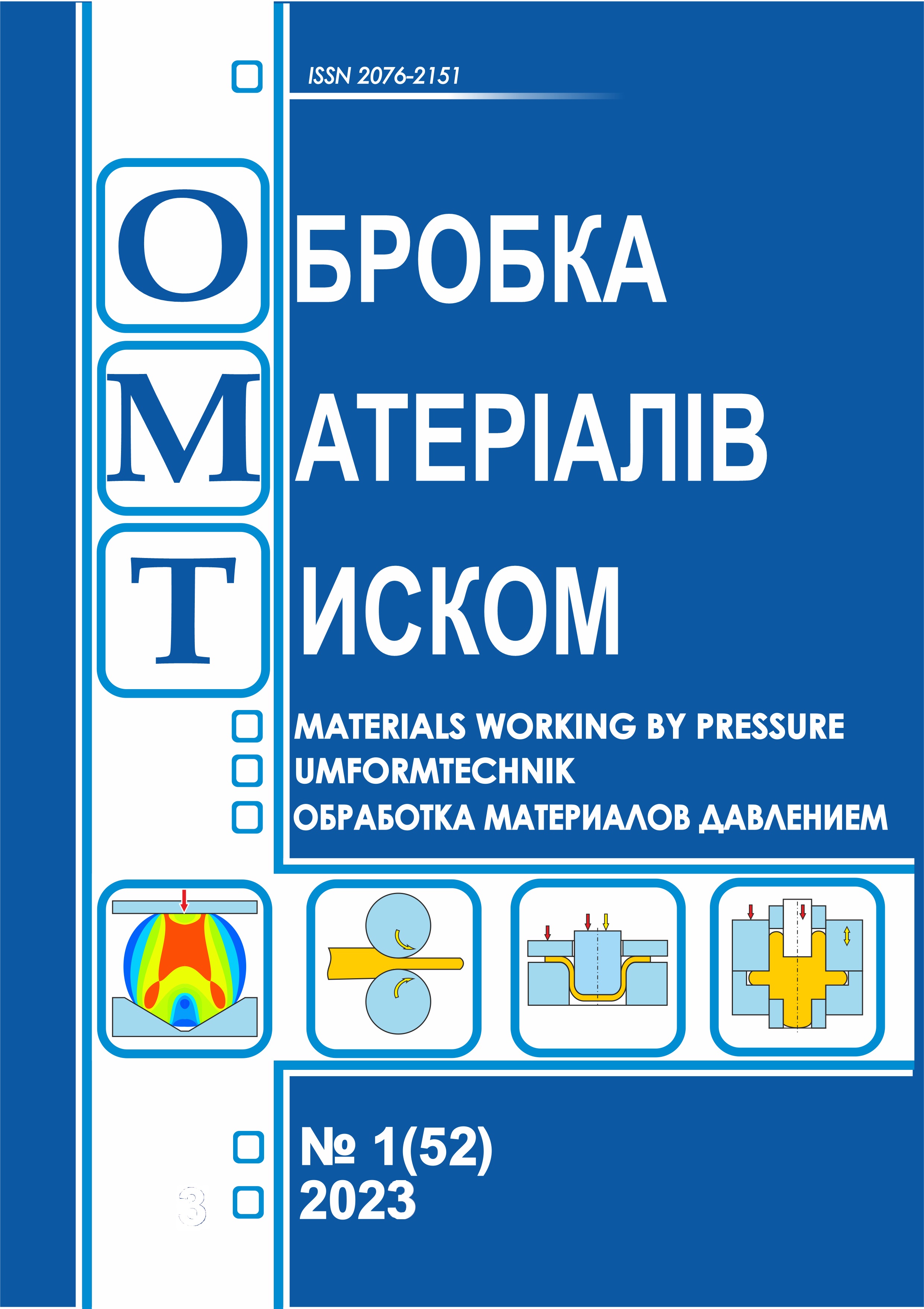Development of promising technologies and designs of equipment for waste-free separation of rolled products
DOI:
https://doi.org/10.37142/2076-2151/2023-1(52)170Keywords:
separation, shear cutting, bending breaking, geometric accuracy, workpiece, quality, reliability.Abstract
Karnaukh S., Chosta N. Development of promising technologies and designs of equipment for waste-free separation of rolled products
The purpose of this work is to develop promising technologies and equipment designs for separating rolled products into cut-to-length billets. Based on the analysis of the developed classifier of non-waste methods for separating rolled bars into cut-to-length blanks, software has been developed for solving the problem of synthesizing combined methods for processing blanks. Using the tools of combinatorics, a search was made for options for implementing waste-free methods for separating long products according to the main features. Based on the results obtained, a technology for the waste-free separation of rolled products and promising designs of equipment for the separation of rolled products into cut-to-length billets have been developed. The essence of the proposed technological and design solutions lies in the fact that the energy of elastic deformation of the frame and the drive of the equipment, which is accumulated and instantly released in the equipment for the implementation of separating operations, is used to perform useful work - applying a stress concentrator. The stress concentrator can be applied both by introducing a wedge knife into the rolled stock and applying a triangular-shaped concentrator, or by partially shifting the workpiece relative to the rod. When applying a stress concentrator in the separation plane, accumulating submicro- and microcracks arise and develop, which leads to the direction of the future macrocrack. In this case, strengthening develops in the volume of the metal adjacent to the fracture plane, accompanied by a change in the mechanical characteristics of the macro- and microstructure of the metal. The tensile strength, yield strength increases, plasticity characteristics decrease. A macrocrack originates on the line connecting the depressions of the notches that occur when the workpiece is displaced relative to the rolled product. The macrocrack can be extremely large, which meets the optimal requirements for the cold bending process. At the same time, additional compressive stresses are created along the entire path of movement of the reduced crack, which are oriented along the required cutting direction, which ensures stabilization of the crack trajectory. The use of the proposed developments makes it possible to obtain high-quality blanks, increase the productivity of the process of separating tubular blanks, expand the technological capabilities of the equipment, increase the reliability of equipment, and improve the culture of production.
References
Solovtsov S. S. Bezotkhodnaya razrezka sortovogo prokata v shtampakh. Moskva: Mashinostroenie. 1985. 176 p. (in Russian).
Finkel V. M. . Kholodnaya lomka prokata. Moskva: Metallurgiya. 1982. 192 s. (in Russian).
Karnaukh S. G., Markov O. E., Aliieva L. I., Kukhar V. V. Designing and researching of the equipment for cutting by breaking of rolled stock. International Journal of Advanced Manufacturing Technology. 2020. 109. pp. 2457-2464.
Karnaukh S. G. Sovershenstvovanie bezotkhodnikh sposobov razdeleniya sortovogo prokata i oborudovaniya dlya polucheniya zagotovok visokogo kachestva: monografiya. Kramatorsk: DGMA. 2010. 196 p. (in Russian)
Yin J-F, Bai Q., Zhang B. Methods for detection of subsurface damage: a review. Chinese Journal of Mechanical Engineering. 2018. 31. pp. 1–14.
Zheng Q., Zhuang X., Zhao Z. State-of-the-art and future challenge in fine-blanking technology. Production Engineering. 2019. 13. pp. 61–70.
Chikishev D. Mathematical modeling of steel chemical composition and modes of thermomechanical treatment influence on hot-rolled plate mechanical properties. The International Journal of Advanced Manufacturing Technology. 2017. 92. pp. 3725–3738.
Zhao P. J., Chen Z. H., Dong C. F. Experimental and numerical analysis of micromechanical damage for DP600 steel in fine-blanking process. Journal of Materials Processing Technology. 2016. 236. pp. 16-25.
Wang S., Chen Z., Dong C. Tearing failure of ultra-thin sheet-metal involving size effect in blanking process: Analysis based on modified GTN model. International Journal of Mechanical Sciences. 2017. 133. pp. 288-302.
Lisunets N. L. Usage of physical and mathematical simulation for improvement of the processes of metal shear cutting. CIS Iron and Steel Review. 2019. 17. pp. 34–38.
Lisunets N. L. Improving the efficiency of the processes of billets manufacture from rolled metal via shift cutting based on simulation. Chernye Metally. 2018. 6. pp. 31–35.
Volkov Yu. S., Livshits A. L. Vvedenie v teoriyu razmernogo formoobrazovaniya elektrofiziko-khimicheskimi metodami. Kyiv: Vishcha shkola. 1978. 120 p. (in Russian).
Saushkin B. P. Kombinirovannie metodi obrabotki v mashinostroitelnom proizvodstve. Metalloobrabotka. 2003. рр. 8-17 (in Russian).
Pat. 106828 Ukraine. Ustanovka dlya lomki sortovogo prokatu (trub). Karnaukh S. G., Karnaukh D. S., Chosta N. V. № u201510764; zayavl. 05.11.2015; opubl. 10.05.2016, Byul. № 9 (in Ukrainian).
Pat. 134611 Ukraine. Ustanovka dlya rozdіlennya prokatu. Karnaukh S. G., Sidyuk D. M. № u201812765; zayavl. 21.12.2018; opubl. 27.05.2019, Byul. №10 (in Ukrainian).
Pat. 134609 Ukraine. Ustanovka dlya rozdіlennya prokatu. Karnaukh S. G. № u201812760; zayavl. 21.12.2018; opubl. 27.05.2019, Byul. №10 (in Ukrainian).
Pat. 125304 Ukraine. Pristrіi dlya vіdrіzki prokatu. Karnaukh S. G. № u201710707; zayavl. 03.11.2017; opubl. 10.05.2018, Byul. №9 (in Ukrainian).
Pat. 147486 Ukraine. Gіdrodinamіchnii khladnolom dlya rozdіlennya trub na mіrnі zagotovki. Karnaukh S. G., Markov O. Є., Chosta N. V. № u202007833; zayavl. 08.12.2020; opubl. 12.05.2021, Byul. №19 (in Ukrainian).

